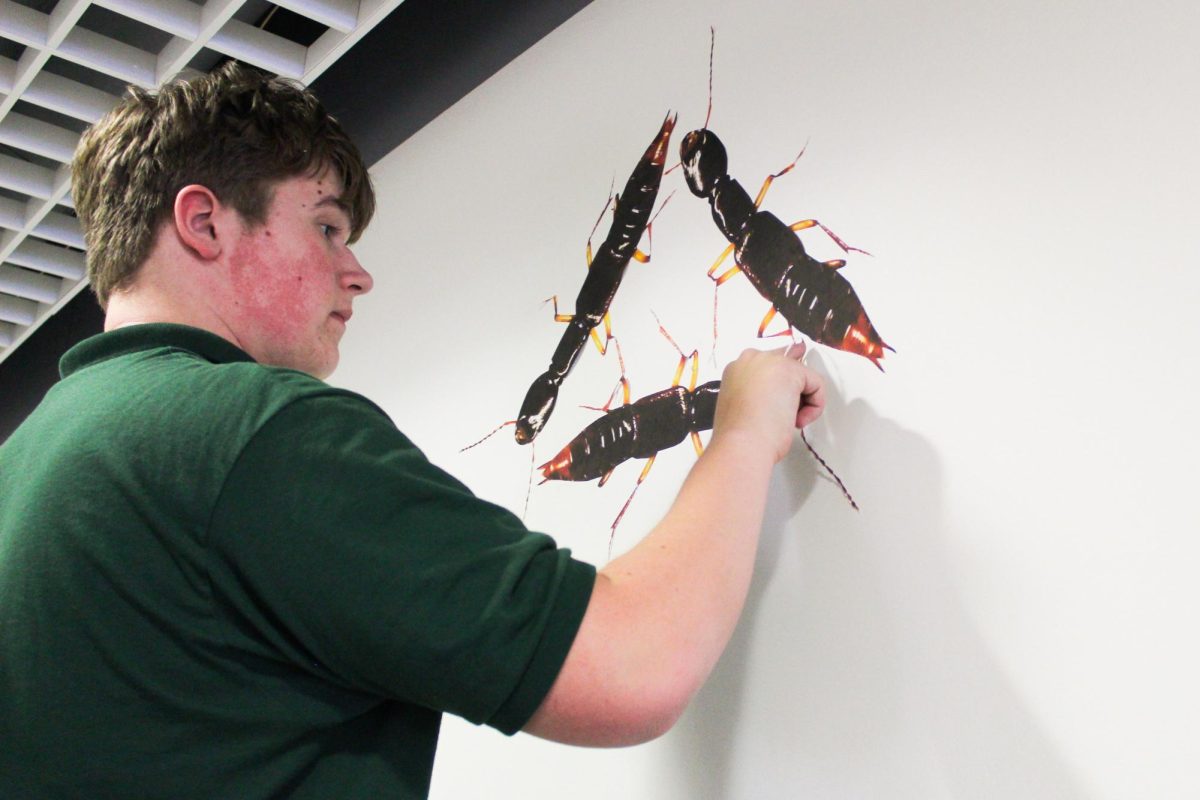Augustana College’s faculty council is debating moving toward a semester model. The administration estimates the switch to semesters would have the potential to generate $2-3 million in revenue from increased recruitment of transfer students.
The revenue and additional students may be needed to keep enrollment steady as the number of Illinois high school students entering college is projected to decline over the next 15 years.
Ellen Hay, faculty council chair, said the council will discuss the trimester/semester debate on March 31, April 15 and May 5.
Hay said she isn’t sure if the faculty will vote this spring or early next fall on the proposal.
If the college decides to switch to a semester system, Kent Barnds, executive vice president of Augustana College, believes that, the college could recruit 100 to 150 additional students over the course of the four year implementation.
On average, students are charged $21,000 annually, which creates an additional $2.1 million to $3.15 million in revenue over the course of those four years.
Barnds said the recruiting and revenue statistics were a collaborative effort by Provost Pareena Lawrence, Evelyn Campbell, dean of students, the faculty and himself.
They found by switching to semesters, the college would gain additional transfer students in the following categories:
- 30 transfer students in January
- 15 first-year students entering mid-year
- 36 students due to “improved first to second-year retention”
- 30 students due to improved recruitment from eliminating “dead times” (or times when the campus is closed due to breaks)
- 30 students due to an “ehanced ability to recruit.”
The estimated 141 transfer students would be offset by five students, due to the increased ease of being able to transfer out, resulting in a net total of 136 additional students during the course of implementation.
Barnds said it’s difficult to recruit students during the mid-year, because unlike most schools that have semesters with a spring term that starts in January, Augustana’s spring term doesn’t begin until March. Barnds said many students don’t want to wait until March.
St. Ambrose University and Luther College had 87 and 14 mid-year transfer students this year, respectively, while Augustana had 7 transfer students enroll in March, said Barnds.
Barnds said this estimated increased amount of transfer students will occur over the course of implementation.
“This isn’t annually that we will attract an additional 30 transfer students,” said Barnds.
Augustana President Steven Bahls said implementing the semester system would have little to no effect on current students, since most of the students would already be gone.
Barnds said after this four year time, the college would be able to prove whether or not the switch has led to an increase of 100 to 150 students.
“In many respects, (the estimates) appear to be pretty conservative, especially when we look at mid-year enrollment numbers from other institutions,” said Barnds.
Fewer high school students enrolling in higher ed
Barnds said the college is in a demographic shift in the next decade where they may need the 100 to 150 transfer students just to maintain enrollment of 2,450-2,500.
“The demographics we face are very concerning,” said Barnds.
Bahls said the population of high school students in Illinois is declining. Lawrence said the population is expected to decline approximately two to three percent for the next 15 years.
Illinois is also the fourth-largest exporter of students to other state colleges and universities, said Lawrence. A drop in enrollment at Augustana would lead to a drop in revenue, forcing the college to make cuts.
“We feel if we don’t do anything, to keep (the college’s population) at 2,500 is going to be challenging in the next few years, just looking at the demographics,” said Lawrence.
It is because of the demographic shift (as well as benefiting the students, reflecting the changing nature of the Augustana student body and holding costs down) that Bahls and Lawrence both favor a change to the semester system. However, both are still calling for a full and fair debate.
“It’s not about increasing our population of students dramatically,” said Bahls. “It’s about maintaining the population.”
Bahls said there are also trends in higher education that point to an increased amount of students beginning at two year community colleges and transferring into four year colleges.
“We must have better ease of transfer between community colleges and Augustana,” said Bahls. “We think it’s best to start at Augustana, not a community college, but the fact of the matter is we’re going to be seeing more of that.”
Bahls said the position of the college administration is that the college can have a program on either trimesters or semesters.
“No one is going to approve of anything that compromises the academic program,” said Bahls.
Bahls said he only favors the change if students can still double major and graduate on time, if the college can enhance internships, international programming and senior inquiry options, and if the college can sustain the balance between general education and major requirements.
One of the reasons Bahls supports the move to semesters is because he believes it would keep costs down, which he said is the biggest concern students bring to him.
“With the dollars involved here, this is the easiest way I see to hold down expenses,” said Bahls. “Obviously, if we can do this, the savings that will be reaped will be used to hold down expenses. Augustana has become expensive.”
Opinions split on effects on programing, student experience
Kirsten Day, classics department chair, said she would support the semester system for pedagogical reasons, but is concerned the plan would cause professors she believes are “already overworked” to become even more so while also potentially endangering smaller departments.
Based on the data, Bahls said with an increased number of transfer students and better retention rate, the college could stabilize the annually fluctuating cost of attendance.
Sophomore transfer student Claire Bacon said she favors the trimester system because of the ability to take more classes and a greater variety of class offerings. She attended Luther College last year.
“Semesters tended to drag on, and by the end of the term I was sick of all my classes even if I had started out loving them,” said Bacon.
David Snowball, communication studies chair, said from a pedagogical perspective, students in a trimester and semester system have the same outcomes. What matters more is the relationship between the students to the professors and to each other, and it doesn’t matter how many weeks those classes are.
Snowball said one issue for him under the semester system would be developing relationships with more students, which has the potential to be difficult. Right now on average, Snowball said he has about 60 students under the trimester system. With semesters, his class sizes could possibly increase towards 90 if the faculty are teaching two courses instead of three.
“I’m really bad with names,” said Snowball. “I sort-of can look at students and think ‘yeah, you’re in class with me,’ but it takes a lot of effort on my part to figure out who my students are, to remember them. So any time I need to track more kids, I’m a little concerned about my ability, especially early in the term, meaningful connections with them.”
However, he says that other schools manage to have pleased students and alumni. Snowball said the question for the college in this changing environment is how to keep the college’s cultural identity.
“We know that we don’t have the option of doing nothing,” said Snowball. “Given the changed environment, the challenge for the college is how to make the changes necessary to remain financially vibrant without losing its culture or identity.”
Snowball said the Augustana ethos has been to make students realize they had more potential than they knew. He said Augustana has two to one or three to one advantages over other colleges, with alumni agreeing to statements like “the college set high standards, but helped me meet them.”
“That’s the ultimate test of any of this,” said Snowball. “Not are we meeting for 10 weeks or are we meeting for 13 or are we meeting for six. The ultimate test is: do we change lives?”
Semester calendar would include J-term
Under the current draft of the proposal for a semester calendar, the semester system would have two terms with an additional January term. A January term is where a student would take one course five days a week. Students would have to take at least two J-terms during their time at Augustana.
Under the proposed system, each course would also count for four credit hours instead of three, and students would typically take four courses in both the fall and spring terms, with that potential one course during the J-term.
Provost Pareena Lawrence said a J-term would allow Augustana to partner with similar institutions, such as Luther College, which would control the cost.
“(A J-term) is a way in which our curriculum could be really innovative,” said Lawrence.
Trimester vs. semester debate nothing new
Hay said in the 27 years she has been at Augustana, this is the fourth time she has had a conversation about a possible switch to a semester system. The last time the potential shift was up for debate, Hay said the faculty favored semesters by 10 votes.
This conversation began because of the results of a campus-wide survey, where one of the concerns brought up was workload. When the faculty council met this fall, the college’s financial sustainability was a topic of conversation, which led to the current debate.
Hay said the faculty is currently in the information-gathering stage, where all facets of the campus were asked to provide pros and cons lists.
“This might be a wonderful opportunity to think about how we really position the offerings that we have to meet the future needs of our students,” said Hay.










































































































